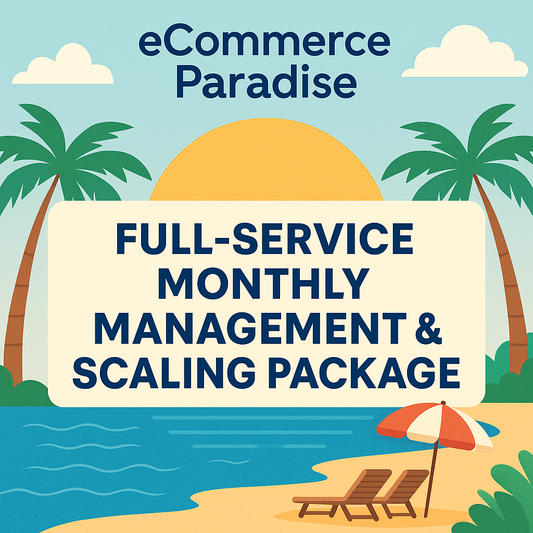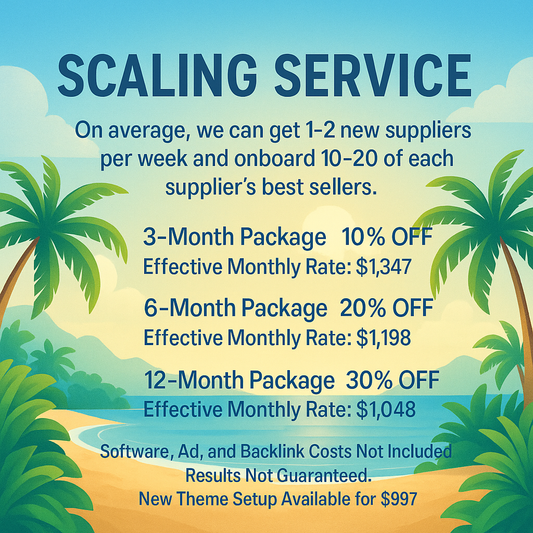
Mastering Meta Tags for Your Shopify Store
Welcome to Ecommerce Paradise! As a passionate entrepreneur, I know the struggles of setting up an online store and attracting the right customers. One of the crucial elements that can make a significant difference in your store's visibility is effectively using meta tags. In this blog post, we're diving deep into how you can leverage meta tags for your Shopify store to boost your visibility, drive traffic, and ultimately increase sales. Let's get started!
Understanding Meta Tags
Meta tags are snippets of text that provide information about your webpage to search engines and web visitors. They are not visible on the page itself but play a pivotal role in optimizing your store for search engines such as Google. When it comes to ecommerce SEO, getting your meta tags right can greatly improve your rankings and visibility.
Types of Meta Tags
To effectively use meta tags, it's essential to understand the different types available. Here’s a breakdown:
- Title Tags: Displayed in search engine results as the clickable headline. It's crucial to utilize important keywords here while making it appealing to users.
- Meta Descriptions: A brief summary of your page, usually around 155-160 characters, that appears below the title in search results. This should include relevant keywords to improve visibility.
- Viewport Meta Tag: This ensures your site is mobile-friendly, adapting to various screen sizes, which is essential for a positive user experience.
- Keywords Meta Tag: While not as influential as they used to be, including related keywords may still benefit your site's overall SEO strategy.
The Importance of Meta Tags in SEO
Utilizing meta tags effectively can lead to increased visibility and higher click-through rates in search results. When setting up your Shopify store, it’s essential to prioritize your meta tags as part of your ecommerce SEO strategy. Well-optimized meta tags can help you rank higher, allowing more customers to discover your products.
Boosting Click-Through Rates
By crafting compelling title tags and meta descriptions, you can capture the attention of potential customers. Think about your target audience when creating these snippets. What are they searching for? What problems are they trying to solve? Using these insights, let's break down how to write engaging meta descriptions:
- Utilize action-oriented language.
- Include relevant keywords but avoid keyword stuffing.
- Highlight unique selling propositions (USPs).
- Create a sense of urgency or exclusivity.
Implementing Meta Tags in Shopify
Now that we understand the essential components and importance of meta tags, let’s discuss how to implement them in your Shopify store effectively. Shopify makes it quite user-friendly to add and edit meta tags.
Accessing Meta Tags
To edit your meta tags in Shopify, follow these simple steps:
- Log into your Shopify admin panel.
- Go to the “Online Store” section and select “Pages.”
- Select the page you wish to edit.
- Scroll down to the “Search Engine Listing Preview” section.
- Click “Edit website SEO” to modify the title and description.
Writing Effective Title Tags
Your title tag should ideally be between 50-60 characters. Here's a simple formula to keep in mind:
Keyword + Unique Selling Point + Brand Name
For example: “Quality Hiking Boots - Durable & Affordable | Ecommerce Paradise.” This structure positions your product effectively and ensures search engine visibility.
Crafting Meta Descriptions
Meta descriptions can be about 155-160 characters. Always start with the most critical information and focus on enticing your customers. Here’s how to do it better:
Focus on relevancy, highlight benefits, and include a call to action.
For example: “Discover a fantastic selection of affordable hiking boots that combine durability and style. Shop now and elevate your outdoor adventures!”
Common Mistakes to Avoid
We all make mistakes, but when it comes to meta tags, avoiding them can save you time and effort in the long term. Here are some common pitfalls to steer clear of:
- Overusing Keywords: While it’s essential to include keywords, overstuffing them can be detrimental. Aim for natural and effective usage.
- Ignoring Character Limits: Ensure you don’t exceed the character limits for title tags and meta descriptions. Overflowing text may get cut off in search results.
- Duplicating Meta Tags: Each page should have unique meta tags. Duplicate tags can confuse search engines and have a negative effect on your ranking.
Fueling Your Marketing Strategies
Meta tags don't just aid in ecommerce SEO; they also tie into other digital marketing strategies. For example, optimizing meta tags can work in synergy with Email Marketing efforts. When sending out newsletters or promotional offers, you can ensure the included links lead to well-optimized landing pages.
Meta Tags and Google Shopping Ads
While we're on the subject of marketing strategies, don’t overlook the significance of meta tags concerning Google Shopping Ads. Well-structured meta tags can enhance your product feed, making it easier for your listings to show up in relevant search results. Properly optimized product titles and descriptions can elevate your visibility and attract the right consumers to your store.
Integrating Dropshipping Techniques
Dropshipping businesses particularly benefit from effective meta tag usage. Since your product range is often vast and competitive, good SEO practices can help you stand out. Use Thoroughly researched keywords unique to your niche when crafting meta tags related to products. This will help you reach your target audience more efficiently and help convert clicks into customers.
Monitoring Your Progress
Once you’ve optimized your meta tags, monitoring your progress is crucial. Use tools like Google Analytics and Google Search Console to track your site's performance and assess the impact of your changes. By analyzing metrics like organic search traffic, click-through rates, and bounce rates, you can gain valuable insights into where you stand and what you need to improve.
A/B Testing for Improvements
Consider A/B testing your title tags and meta descriptions to find out what resonates best with your audience. Change up the title or description, and monitor which variations drive more traffic. This can significantly inform your future optimization strategies.
Empowering Your Online Success
As you embark on your meta tag optimization journey, remember that great SEO takes time and meticulous attention to detail. With effective meta tags in place, the door opens to enhanced visibility, improved click-through rates, and an increase in sales.
By incorporating these practices into your Shopify store, you position your business for success in the competitive ecommerce landscape. Remember that SEO is not just about reaching the top of search results, but about creating a meaningful experience for your customers. Your success story is within reach at Ecommerce Paradise, so roll up your sleeves and get to optimizing!


















